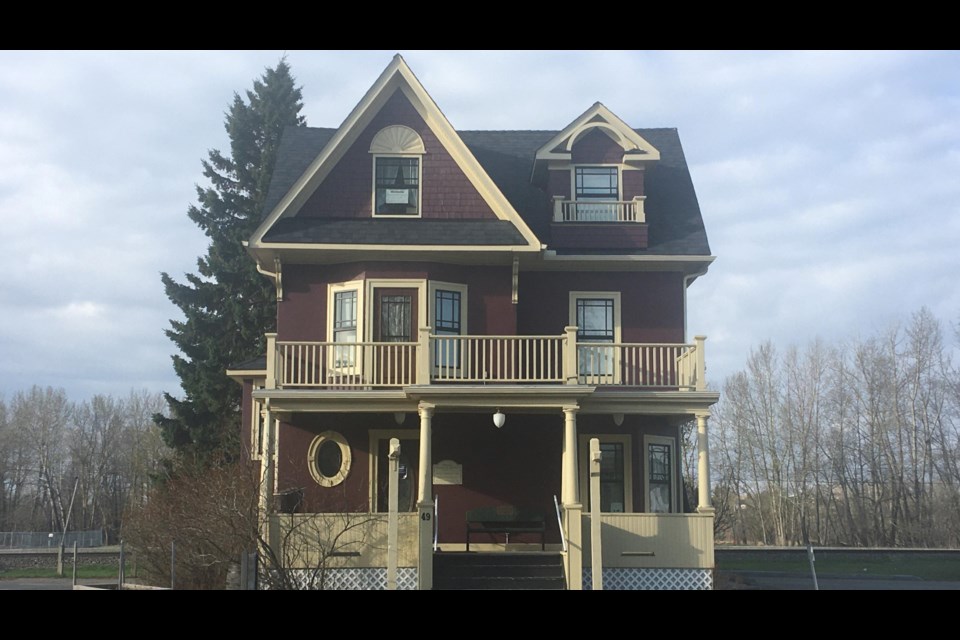An Okotoks landmark is celebrating a milestone anniversary this month.
“The Okotoks Museum and Archives is turning 20 in 2020,” said Kathy Coutts, museum specialist.
To celebrate, a come-and-go open house will be held at the museum on Sept. 12 from 11 a.m. to 4 p.m. to encourage people to check out what’s new in the exhibits and see a video presentation of the house’s move down main street in July 2000.
The house had been located at the bottom of Northridge Drive, just east of the current Royal Bank building, and was slated for demolition as the road was widened coming into town.
Tracie Ward, a former arts and culture manager for the Town, wasn’t about to let that happen. Along with the Okotoks and District Historical Society and numerous community sponsors, donors and volunteers, as well as the support of Okotoks councillors at the time, she arranged to have the house moved to sit at its current location, next to the Okotoks Art Gallery (then known as The Station).
“The community rallied together to help fundraise for the move and it was relocated here, put on a brand-new foundation, then over the months of July and August the house took on new life as a museum and archives and officially opened on Sept. 7 in 2000,” said Coutts.
The archives had been previously housed in a small room inside the Okotoks Public Library, which had been paid for by the historical society when the original building was constructed in 1992, but its stores quickly outgrew the space, which was also required by the library to expand its operations.
“When the opportunity came to repurpose this building, Tracie Ward was really instrumental in doing the legwork, the behind-the-scenes work through grants and rallying up volunteers to relocate it to this location, then open it as a museum,” said Coutts.
For months leading up to the move, a sign with an arrow hung on the side of the house to indicate where donations sat and raise awareness of the move, which was “quite an undertaking,” she said.
The three-storey house was lifted onto a flatbed trailer and moved – slowly – down Elizabeth and McRae Streets before coming to its final destination on North Railway Street. Along the way, power lines had to be raised.
A pancake breakfast in the parking lot of the art gallery raised more dollars for the move and brought together the community in celebration of a monumental moment for the Town.
“That day was like a parade,” said Coutts. “People lined the streets in July to watch the house move.”
She said the house handled its move remarkably well – likely a sign of the quality of craftsmanship that went into constructing homes at the turn of the 20th century. Only a couple of cracks showed up after it had settled, along with some other minor issues.
“The floors aren’t necessarily level,” said Coutts. “I know upstairs outside the washroom it’s very sloped, but it’s still just beautiful.
“It’s just a fabulous building and I’m so glad people had the foresight to preserve it and repurpose it.”
There have been a few changes over the museum’s two decades – most notably the paint colour, which was originally a light grey and now has a deep plum hue. The landscaping around has been developed over the years and inside, the windows were replaced in order to make the space suitable for delicate museum artifact displays, she said.
Wallpaper, light switches and curtains inside were all replaced with period-appropriate fixtures to keep up the homey feeling of a century-old house, she said. Now, it’s hard to tell the building was ever moved at all.
“It really fits into this end of the street, so close to the train station and the old post office,” said Coutts. “It really is surrounded by a lot of century-old buildings.”
In the basement, temperature, humidity and light controls are in place to protect the archives, which consist of documents, photographs and maps, which can become yellowed or brittle over time without proper care, she said.
“It’s all controlled because as a museum and archives we are the stewards of our community’s history and we want to preserve it as long as possible,” said Coutts.
Part of that work involved digitizing the archives to prevent the loss of documents – particularly handwritten notes or papers – which can fade over time, she said.
It’s a long and slow process, but each item in the archives is making its way into a digital file so nothing is lost, she said.
For more information visit www.okotoks.ca
Krista Conrad, OkotoksToday.ca




